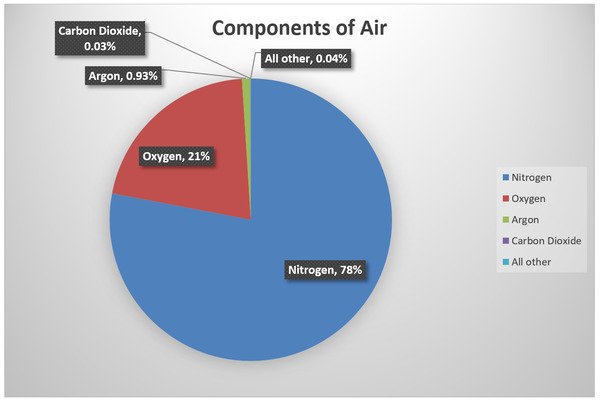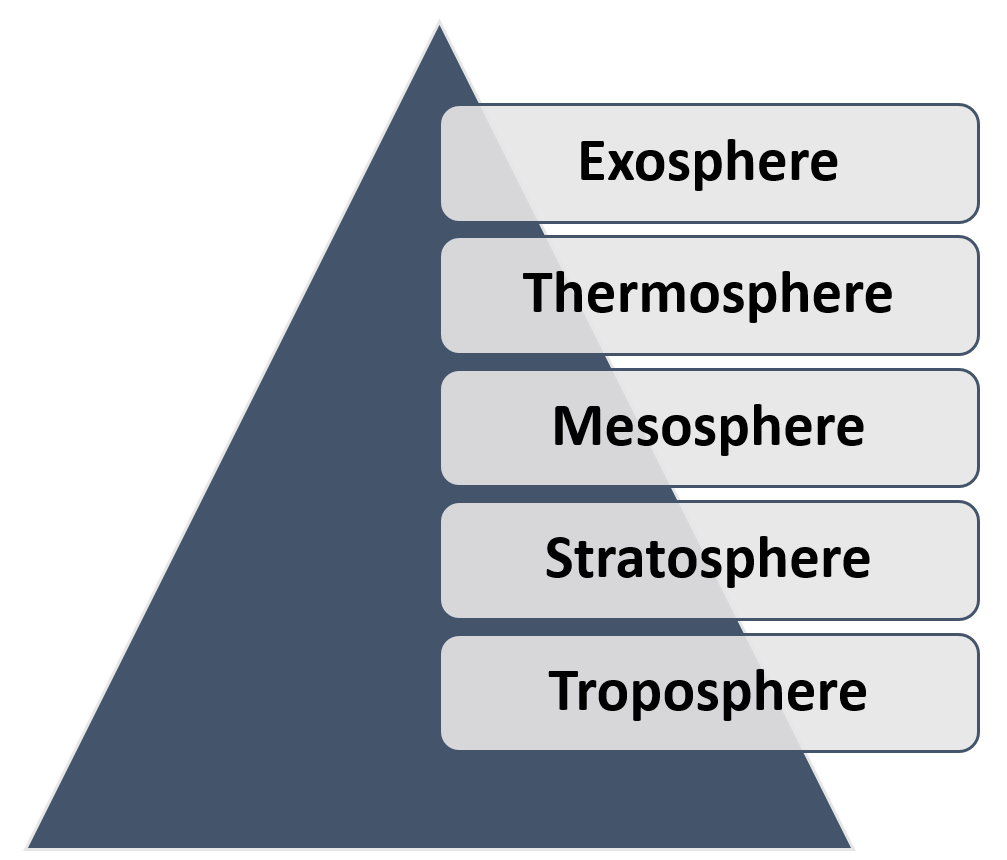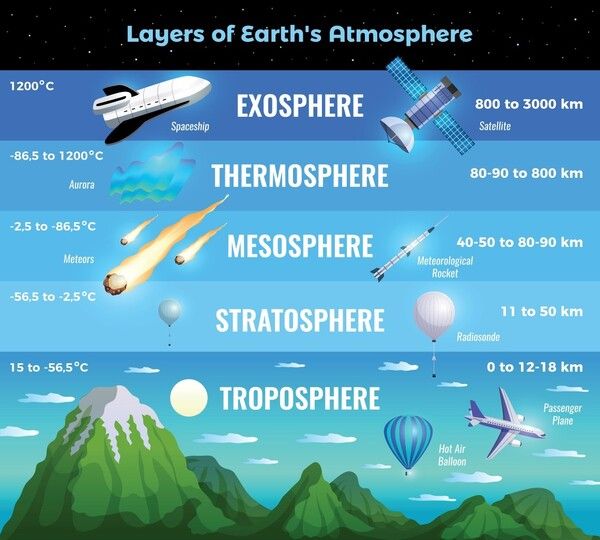Atmosphere: Composition and Structure | Layers of Atmosphere
1. Atmosphere
Our earth is surrounded by a huge cover of air, which is called the atmosphere. The survival of all living things on our earth is dependent on the atmosphere. It gives us the oxygen we breathe and protects us from the sun's damaging rays. We would be burned alive by the sun during the day and frozen at night if we didn't have this layer of protection. As a result, it is this mass of air that has kept the earth's temperature bearable.
Earth's atmosphere extends up to 10,000 kilometers (6,214 mi) above the planet's surface. After that, the atmosphere mixes into space.
2. Composition of the Atmosphere
The air we breathe in is actually a mixture of several gases. A majority portion of the atmosphere is composed of two gases: nitrogen and oxygen. Carbon dioxide, helium, ozone, argon, and hydrogen are all present in smaller quantities.
Besides these gases, there are also small dust particles in the air.

Fig.1: Composition of Air
2.1. Nitrogen
- Nitrogen is present in the largest amount in the atmosphere.
- The nitrogen level in the atmosphere is around 78%.
- When we breathe, we take some amount of nitrogen into our lungs and release it.
- Plants, on the other hand, need nitrogen to survive. They cannot take nitrogen directly from the air.
- Bacteria living in the soil and roots of some plants take nitrogen from the air and change its form so that plants can use it.
2.2. Oxygen
- The second most plentiful gas in the atmosphere is oxygen.
- The oxygen level in the atmosphere is around 21%.
- Both humans and animals breathe, where they absorb oxygen from the air. During photosynthesis, green plants produce oxygen. As a result, the amount of oxygen in the air remains constant.
- When we cut down trees, the balance is disturbed.
2.3. Carbon Dioxide
- Another important gas is carbon dioxide.
- Around 0.037% of carbon dioxide is found in the atmosphere.
- Carbon dioxide is used by green plants to create food and oxygen is released.
- Carbon dioxide is released by humans and animals.
- The quantity of carbon dioxide emitted by humans and animals seems to be equal to the amount consumed by plants, resulting in a perfect balance.
- The burning of fossil fuels like coal and oil, on the other hand, throws the balance off.
- Every year, they emit billions of tonnes of carbon dioxide into the environment.
- As a consequence, the increasing amount of carbon dioxide in the atmosphere has an impact on the weather and temperature of the earth.
- The greenhouse effect is mostly caused by carbon dioxide.
2.4. Other gases
- Argon is found 0.9% in the atmosphere, while other gases are found at just 0.1%.
- Other gases that are found in the remaining 0.1% include small amounts of carbon dioxide, methane, water vapour, and neon.
3. Structure of the Atmosphere
The Earth's atmosphere is divided into five primary layers and many secondary layers. The Troposphere, Stratosphere, Mesosphere, Thermosphere, and Exosphere are the primary layers, from lowest to highest.

Fig.2: Layers of Atmosphere
3.1. Troposphere
- The troposphere is the atmosphere's innermost layer.
- “Tropos” means change. This layer gets its name from the weather, which is continuously changing and mixing up the gases in this region of our atmosphere.
- It extends from Earth's surface to a height of approximately 12 kilometres (7.5 miles), with minimum height at the poles and maximum height at the equator.
- It is thinnest at the North and South Poles.
- This layer contains the air we breathe as well as the sky's clouds.
- Most of the atmospheric phenomena, such as rain, fog, and hailstorms, take place in this layer.
- This layer is responsible for holding all the air that plants need for photosynthesis and animals need for breathing.
- It also comprises about 99% of all water vapour and aerosols (minute solid or liquid particles suspended in the atmosphere).
- Being the lowest layer, the troposphere contains more than three quarters of Earth's atmospheric gas.
- Here, the air contains 78% nitrogen and 21% oxygen. Argon, water vapour, and carbon dioxide make up the last 1%.
- The temperature usually goes down the higher you go, because most of the heat found in the troposphere is generated by the transfer of energy from the Earth's surface.
- The troposphere is the densest layer of the atmosphere, and it is compressed by the weight of the atmosphere above it.
- The stratosphere is the layer directly above the troposphere.
- The "Tropopause" is the boundary between the troposphere and the stratosphere.
3.2. Stratosphere
- Above the troposphere and below the mesosphere lies the stratosphere.
- “Strat” means layer. When you go up, it is the second layer of the atmosphere.
- The stratosphere is located between 12 and 50 kilometres above Earth's surface.
- Although the stratosphere is mostly cloud-free and weather-free, polar stratospheric clouds (PSCs) may sometimes be seen at their lowest, coldest levels.
- It provides perfect circumstances for flying aeroplanes.
- The stratosphere is home to the Earth's ozone layer, which protects humans from harmful UV radiation from the Sun.
- Ozone warms this layer by absorbing energy from the Sun's ultraviolet light.
- There is an increase in temperature as we move upwards through the stratosphere. This is quite opposite to the behaviour of the troposphere.
- The tropopause is the lower boundary of the stratosphere, whereas the stratopause is the upper boundary. Stratopause is the boundary between the mesosphere and the stratosphere.

Fig.3: Layers of Atmosphere
3.3. Mesosphere
- The mesosphere lies above the stratosphere and below the thermosphere.
- “Meso” means middle. This is the third layer of the atmosphere.
- The mesosphere, which is located between 50 and 80 kilometres above Earth's surface, becomes colder as height increases.
- This is the topmost layer of the atmosphere in which the gases are all mixed up rather than being layered by their mass.
- In the mesosphere, the air is still too thin for us to breathe.
- Meteorites burn up in this layer when they enter space.
- In fact, with an average temperature of minus 85 degrees Celsius (minus 120 degrees Fahrenheit), the top of this layer is the coldest place found near the earth.
- The mesopause is the boundary between the mesosphere and the upper layer thermosphere.
3.4. Thermosphere
- Above the mesosphere and below the exosphere lies the thermosphere.
- “Thermo” means heat. This layer may reach temperatures of up to 4,500 degrees Fahrenheit.
- The thermosphere is located between 80 and 700 kilometres above Earth's surface and includes the ionosphere at its lowest point.
- In the thermosphere, the temperature increases very rapidly with increasing altitude.
- This layer helps in the transmission of radio signals.
- It reflects radio waves back to the ground that is broadcast from the earth.
- The International Space Station is situated in the thermosphere as it orbits Earth. Low Earth orbit satellites may also be found here.
- The thermosphere absorbs a large portion of the Sun's X-ray and UV radiation.
- Aurora borealis and aurora australis are occasionally seen here.
- Thermopause is the boundary between the thermosphere and the exosphere.
3.5. Exosphere
- The exosphere is the outermost layer of Earth's atmosphere, located between 700 and 10,000 kilometres (440 and 6,200 miles) above the surface.
- “Exo” means outside. The top of the earth combines with the solar wind.
- The rest of the atmosphere is separated from outer space by this layer.
- Gases like hydrogen and helium are present in the exosphere, but they are very spread out.
- The temperature is very low here and there's no air to breathe.
- The majority of Earth's satellites orbit in the exosphere.
4. Ionosphere
- In the atmosphere, there is a very active part called the ionosphere.
- It grows and shrinks based on how much energy it gets from the Sun.
- The name ionosphere derives from the fact that solar light excites gases in these layers, causing them to generate ions, which have an electrical charge.
- The ionosphere overlaps the mesosphere, thermosphere, and exosphere.
- Parts of the ionosphere overlap with the magnetosphere of Earth.
- The magnetic field of Earth is felt by charged particles in this area around the earth.
- The magnetic fields of both the Earth and the sun affect charged particles in the ionosphere.
- This is where auroras happen. They are bright, beautiful bands of light that are sometimes seen near Earth's poles.
- This layer of our atmosphere is affected by high-energy particles from the sun that interact with the atoms.
Need to know Facts:
Some Facts about Carbon dioxide:
- Carbon dioxide in the atmosphere causes a greenhouse effect by trapping heat emitted from the earth. That's why it is called a greenhouse gas, and without it, the earth would be so cold that it would not be possible to live on it.
- When its level in the atmosphere rises because of factory smoke or car smoke, the heat retained raises the earth's temperature. This is called global warming.
- This temperature increase results in the melting of snow in the world's coldest regions. As a consequence, the sea level increases, creating coastal flooding.
Some Facts about Air:
- When air is heated, it expands, lightens up, and rises.
- Cold air is denser and heavier than warm air. That's why it starts sinking.
- When warm air rises, cold air from the surrounding area reaches there to fill the gap. This is how air circulation takes place.
A barometer is a scientific instrument used to measure atmospheric pressure.
Summary
- Our earth is surrounded by a huge cover of air, which is called the atmosphere. The survival of all living things on our earth is dependent on the atmosphere.
- A majority portion of the atmosphere is composed of two gases: nitrogen and oxygen. Carbon dioxide, helium, ozone, argon, and hydrogen are all present in smaller quantities.
- When we breathe, we take some amount of nitrogen into our lungs and release it. Plants, on the other hand, need nitrogen to survive.
- The second most plentiful gas in the atmosphere is oxygen. Both humans and animals breathe, where they absorb oxygen from the air.
- Carbon dioxide is used by green plants to create food and oxygen is released. Carbon dioxide is released by humans and animals.
- The Earth's atmosphere is divided into five primary layers and many secondary layers.
- The troposphere is the atmosphere's innermost layer. The layer we call home.
- Above the troposphere and below the mesosphere is the stratosphere. When you go up, it is the second layer of the atmosphere.
- The mesosphere lies above the stratosphere and below the thermosphere. This is the third layer of the atmosphere.
- Above the mesosphere and below the exosphere lies the thermosphere. This layer may reach temperatures of up to 4,500 degrees Fahrenheit.
- The exosphere is the outermost layer of Earth's atmosphere. It's really cold there and there's no air to breathe.
- In the atmosphere, there is a very active part called the ionosphere. It grows and shrinks based on how much energy it gets from the Sun.
- Carbon dioxide in the atmosphere causes a greenhouse effect by trapping heat emitted from the earth.






 Latest
Latest 



Comments